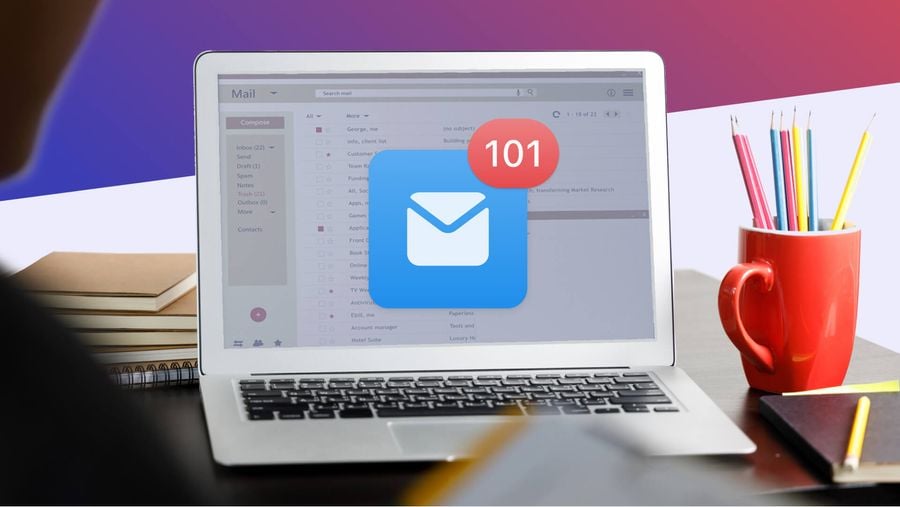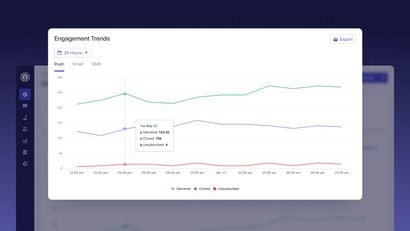The email inbox has long been the destination for brands to flex low-cost, high-ROI marketing campaigns using a channel guaranteed to drive awareness. A finely tuned email marketing strategy can see up to $45 returned for every ad dollar spent. However, an email marketing list that’s left uncared for will become bloated with inactive subscribers, unverified recipients, and a bounce rate to make even the most optimistic marketers blush.
Below we’ve laid out everything you need to perform a bit of email marketing maintenance. It’s one of the best ways to improve email KPIs without undergoing any costly re-strategizing.
A car only drives as well as its engine is maintained, and a marketing campaign only performs as well as its email list is optimized. Struggling with open and click-through rates? Don’t buy a whole new car, just give it a tune-up.
Looking for one, inclusive email campaign cheat sheet? The OneSignal Guide to Email Optimization is a bookmark-friendly checklist to ensure your emails are pulling their marketing weight for you!
What's below:
- How Do You Clean Your Email List?
- Why Cleaning an Email List is Important
- Identifying Inactive Subscribers
- Removing Unengaged Subscribers
- How to Handle Bounced Emails
- Verifying Email Addresses
- Complying With Anti-Spam Laws
What Does Cleaning an Email List Mean?
Cleaning a marketing email list refers to the process of organizing or removing invalid, outdated, and inactive email addresses from your email marketing campaigns. Cleaning your email list has been proven to boost email campaign effectiveness and reduce the chances of your marketing campaigns being mistakenly categorized as spam.
How to Clean an Email List
The email list cleaning process typically includes the following tasks:
- Identifying and removing duplicate email addresses
- Correcting formatting errors
- Removing invalid email addresses that bounce back undeliverable messages
- Removing subscribers who have not engaged with the emails for a significant period of time
The overall goal: Ensure that the emails you’re sending to subscribers are delivered to active and engaged recipients.
Why Cleaning an Email List is Important
Cleaning your email list is as much an important housekeeping item as it is an exercise in “quality over quantity.” If left unchecked, a congested email list eventually becomes merely a collection of uninterested, dormant, or inactive recipients. A clean email list, if maintained regularly, can increase the deliverability of your email campaigns in a variety of ways.
What is email deliverability?
The ability of your emails to reach the right people at the right time.
In short, a clean email list comes with the following benefits:
- Combat unsubscribes by ensuring that the majority of your emails are being sent to users who are actually engaging with them.
- Limit spam complaints and help maintain your reputation with your ESP by removing uninterested recipients.
- Uncover re-engagement opportunities due to the identification of inactive subscribers.
- Should reengagement fail, you can still improve your open-rate due by removing said inactive subscribers.
- Save money. If your ESP charges you based on number of emails sent, cleaning out your email list will buy you some savings by “trimming the fat.”
Read this guide to learn more about all the factors that contribute to email deliverability.
Identify Inactive Subscribers
How do you determine who to keep and who to remove?
An inactive subscriber is someone who has previously subscribed to receive emails from your business but has not opened, clicked, or otherwise engaged with your emails for a significant amount of time. A “significant amount of time” varies by company and can range anywhere from three months to an entire year.
Inactive subscribers can be identified in the following ways.
Analyze Email Engagement Metrics
By analyzing your email engagement metrics (open rates, click-through rates, and conversion rates), you can pinpoint subscribers who haven't opened or clicked on any of your emails in a particular period.
Set Up Email Automation Workflows
Email automation workflows can be set up to monitor subscriber engagement levels and eliminate much of the manual back and forth. For example, you may automate a workflow to trigger when a subscriber hasn't opened an email in a certain amount of time. If the subscriber doesn't engage with subsequent emails, they can be automatically flagged as inactive.
Use Re-Engagement Campaigns
Re-engagement campaigns are powerful tools for bringing back subscribers who have been MIA. These campaigns typically include special offers or incentives to encourage re-engagement. If your re-engagement campaigns are not getting any traction, then it may be time to reclassify those subscribers as inactive.
Once you’ve identified your inactive users, you may want to consider adding them to a suppression list. A suppression list is a place to keep all email addresses that are excluded from receiving marketing emails and is a helpful way to make sure you’re only sending emails to engaged subscribers.
Remove Unengaged Subscribers
Let's look at some tips for a healthier email list.
Similarly to inactive subscribers, unengaged subscribers describe those who have subscribed to receive emails from your business but are not interacting with them in a meaningful way. These subscribers may still be receiving and opening emails, but not clicking through any of the links inside. These subscribers aren’t necessarily “dead,” they simply may need some additional follow-up to bring them back to the table.
Identifying and reaching these unengaged subscribers can be done through targeted re-engagement campaigns, which may include special offers or incentives, and personalized content designed to bring them back into the sales funnel. While email follow-ups can be very effective in re-engaging subscribers, the use of cross-channel messaging (such as incorporating push notifications) has been known to be a more powerful approach for re-engagement.
Unsure which channel to go with? Our guide on the re-engagement efficacy of email vs. retargeting Ads vs. push notifications breaks everything down for you.
If efforts to re-engage unengaged subscribers are unsuccessful, it may be time to remove them from the email list to maintain the overall health and effectiveness of the email campaign.
Why Bounced Emails Happen and How to Handle Them
A bounced email is an email message that is returned to the sender because it was unable to be delivered to the recipient's email address. These emails can be rejected by the recipient's email server for a variety of reasons — to read the full list of why emails bounce, read our walkthrough here.
On a simplified level, there are two types of bounced emails: hard bounces and soft bounces.
A hard bounce occurs when an email is returned to the sender because the recipient's email address is invalid, does not exist, or has been deactivated.
A soft bounce occurs when an email is returned to the sender because of a temporary issue with the recipient's email server, such as a full mailbox or a connection timeout.
In both cases, you will be notified of the delivery failure.
Bounced emails can negatively impact your email reputation and deliverability rate. If too many emails bounce, it could indicate to your ESP that you are sending unsolicited or irrelevant content, which could result in future emails being flagged as spam or blocked.
To minimize bounced emails, email marketers should maintain a clean email list by regularly doing the following:
- Remove inactive and unengaged subscribers (should re-engagement fail)
- Remove hard bounce email addresses after every campaign
- Utilize a double opt-in to ensure high-quality subscribers
- Avoid common spam triggers
- Send relevant and valuable content to subscribers
To learn more about which spam triggers you should be avoiding in your email campaigns, check out the best email optimization tips here!
How to Verify Email Addresses
Verifying email addresses is a great way to get ahead of campaign roadblocks that arise from a disorganized email list. Email verification helps to reduce bounce rates, bolster deliverability rates, and ensure your email list is comprised of engaged subscribers who are driving value to your marketing efforts.
The following strategies include the high-level best practices for making sure your emails are being delivered to the right recipients:
- Double opt-in: After a subscriber submits their email address, they receive a confirmation email that requires them to click a verification link to confirm their subscription. Employing a double opt-in process helps guarantee the authenticity of your subscriber list by filtering out those who may have subscribed to your email list by accident.
- Email verification services: Leveraging a reputable email verification service can help verify your email subscribers in bulk to determine the accuracy of your send list. These verification services use algorithms to check the syntax, domain name, and mailbox status of your email addresses to provide helpful verification statuses.
- Use a reputable email service provider: An effective email service provider will have built-in functionality to auto-detect invalid email addresses and bounce backs. Many providers also include automatic systems that remove inactive and invalid email addresses to maintain a clean list.
- Regularly clean email list: The best approach to a clean email list is a proactive one. By regularly cleaning your email list and constantly monitoring bounce rates, you dramatically lessen the likelihood of unverified subscribers tanking your email marketing metrics.
Comply With Email Spam Laws
No matter how aggressive your marketing strategy is, you must have recipients’ consent to receive emails from your business. Your reputation as an email sender largely hinges on your ability to comply with relevant anti-spam laws. Anti-spam laws vary by country and can include requirements like explicit opt-in permissions, visible unsubscribe links in every email sent, and the prohibition of purchased email lists.
The three largest anti-spam laws to be aware of are the CAN-SPAM Act, GDPR, and CASL.
CAN-SPAM Act (United States) — This federal law was passed in 2003 and outlines clear regulations for email marketers, including unsubscribe link requirements, accurate header and subject line information, and prerequisites for identifying your marketing emails as advertisements. The CAN-SPAM Act also outlines strict constraints surrounding the use of deceptive subject lines or misleading header information.
GDPR (Europe) — The GDPR was introduced in 2016 and applies to all organizations conducting business in the EU. The primary goal of the GDPR is to give consumers sufficient control of their own private data and require businesses to be transparent with how they use said data (and when it is involved in a privacy breach.)
CASL (Canada) — Established in 2014, and much like the above two laws, the CASL regulates the sending of commercial electronic messages and requires email marketers to obtain express consent from individuals before sending them commercial emails. The law also requires email marketers to provide accurate sender identification information and a physical mailing address.
You know how some rules are more “suggestions” than anything else? Anti-spam laws are NOT those rules.
These federal laws are strictly enforced and have been known to come with severe penalties for non-compliance, including fines (in the millions of dollars), immediate legal action, ISP or ESP blacklisting, and even criminal charges.
Do yourself a favor and familiarize yourself with these anti-spam laws now so you won’t have to pay the price later. Ready to become an expert on compliance regulations? We’ve assembled the four things you need to know about email compliance to get you started.
It’s Never Too Late (Or Too Early) For Email Spring Cleaning
Fine-tuning your email marketing list starts with granular personalization and sophisticated automation. OneSignal is the go-to platform of choice for businesses seeking high-engagement cross-channel messaging in a way that doesn’t break the bank. We’ve simplified the process of sending hyper-relevant marketing emails without requiring you to sacrifice campaign control. The best part? Our email composer tool integrates effortlessly with eligible existing ESPs like Mailgun, SendGrid, and Mailchimp.
Create a Free Account



